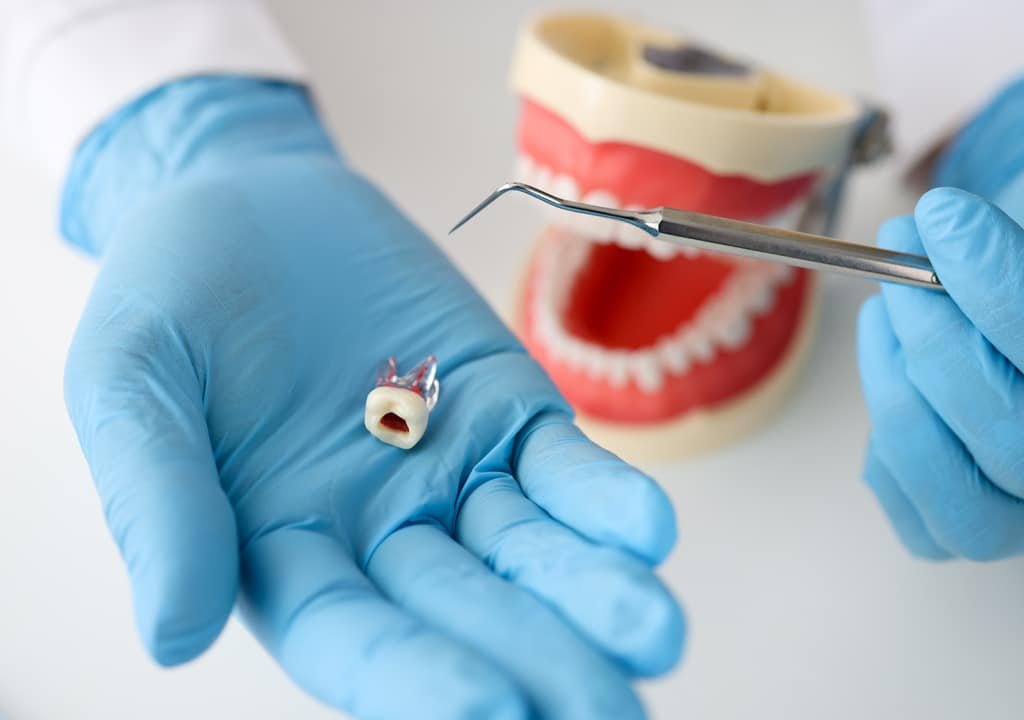Blog
Common Symptoms of a Root Canal Infection
Introduction:
We have compiled this article on “Common Symptoms of a Root Canal Infection”. The reference links are at the bottom of the article.
[1]Infections of the root canal space and their sequelae can be extremely painful and potentially dangerous, yet they do not necessarily have to be. Chronic, asymptomatic inflammatory lesions around the apex of a tooth with a necrotic dental pulp or an insufficient root canal treatment can develop unnoticed by the patient and remain so for years. The course of disease is modulated by both the virulence of the microbiota established in the root canal space and the capacity of the immune system to curb the infection. To both ends, highly convincing investigations to help us understand when and why the tissues around an endodontically involved tooth become acutely inflamed are missing. We will discuss how recent advances in molecular identification of microorganisms have altered our understanding of root canal infections, and which information is currently missing to link clinical experience with observations from experimental research.
[2]Root canal infection is a microbial infection of the tooth that is the most common cause for tooth pain. Knowledge of root canal pathogens and the inflammatory responses they elicit is a prerequisite to our understanding of the pathogenesis of root canal infections. Root canal infections are mostly accompanied by some clinical signs and symptoms such as pain, periapical lesion, tenderness to percussion, swelling, and sinus tract. These symptoms may be the consequence of the presence of bacterial irritants causing an inflammatory response of the periapical tissues. While many different bacterial species are able to colonize the dental root canals, it has been shown that there is a correlation between the presence of specific bacteria and some endodontic symptoms and signs. Knowledge regarding the nature of endodontic microbiota depends upon the recognition of those microorganisms present in the root canal system of teeth with necrotic pulp and failed endodontic treatment.
The literature on root canal infections shows that root canal harbors an array of microorganisms.
[3]Why You May Need Retreatment After A Root Canal
Even when every step of the procedure goes smoothly, a tooth that is treated with a root canal may experience prolonged sensitivity or reinfection. According to the American Association of Endodontists (AAE), certain circumstances may prevent a tooth treated with a root canal from healing properly:
If the dental professional misses tiny, hidden canals or curved canals during the first treatment, the bacteria inside them may not be entirely removed and can cause infection.
Immediately after the root canal, the dental professional often places a temporary filling to provide a short-term seal for the root canal before placing the permanent restoration (such as a crown or filling). If there is a delay in placing the permanent restoration, there is a greater chance that the root canal can get reinfected.
If bacteria in the saliva get under the filling material before the filling is placed, the canal can become reinfected.
If the patient doesn’t maintain proper oral hygiene, new cavities can form on the same tooth that already received a root canal.
A filling or crown placed on the tooth that received the root canal can crack, loosen or break, allowing a new infection to start.
Symptoms Of Lingering Endodontic Problems
When any of the previous circumstances occurs with your root canal tooth, you may experience a range of symptoms. Here are some signs that indicate it may be time to make an appointment with your dental professional, according to the AAE:
- Sensitivity to hot and cold, or lingering pain after consuming hot or cold food
- Sharp pain when biting down or when tapping the teeth together
- Constant pain and pressure
- Swelling of the gums, with or without the presence of a pimple-like bump near the tooth on the gums
- A dull ache experienced consistently in the same area
These symptoms indicate there may be an issue with the pulp of the tooth, which is the interior portion of the tooth treated by a root canal procedure.
How A Dental Professional Can Help
Your general dentist or endodontist will usually take X-rays to assess the condition of the tooth in question. The AAE notes that endodontists are specialized dental professionals who have received two to three additional years of education to diagnose and treat infections inside the tooth.
When you experience issues with a previously treated tooth, it may be necessary for an endodontist to reopen the tooth, explains the AAE. This process, called endodontic retreatment, allows the dentist to remove the original root canal filling material and reclean and reseal the canals. Following this procedure, they will place a temporary filling and you will receive your permanent restoration at a later appointment.
If you have a severe toothache or other old root canal infection symptoms, don’t hesitate to book an appointment with your dentist. When these conditions are addressed early, your dental professional can successfully retreat teeth and maintain your smile.
Conclusion:
Thank you for reading this article, and check back frequently for other dental health articles. Should you have any questions, please contact Apple Tree Dental today!
Article compiled by Apple Tree Dental
Article reference links


